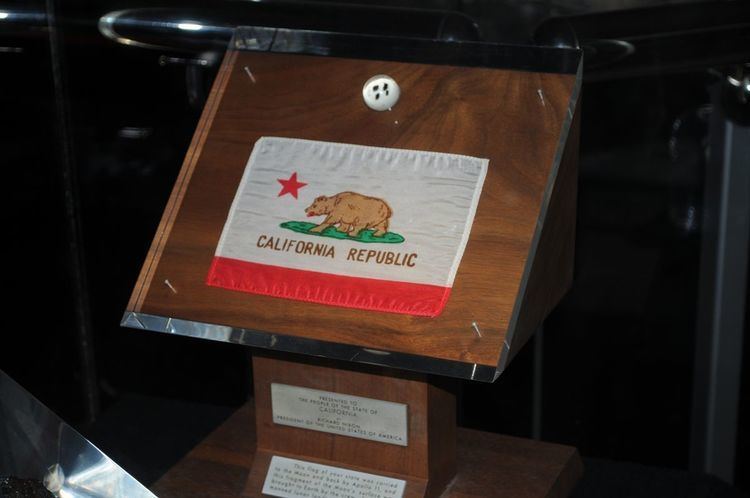 | ||
The California lunar displays are two commemorative plaques consisting of small fragments of moon specimen brought back with the Apollo 11 and Apollo 17 lunar missions and given in the 1970s to the people of the state of California by United States President Richard Nixon as goodwill gifts.
Contents
Apollo 11
The California Apollo 11 lunar sample display commemorative plaque display consists of four "moon rock" rice-size particle specimens that were collected by Apollo 11 astronauts Neil Armstrong and Buzz Aldrin in 1969 and a small California state flag that was taken to the moon and back on Apollo 11.
The 4 "moon rocks" weigh about 0.05 grams total and are entirely enveloped in a clear plastic button the size of a coin which is mounted to a wooden board approximately a foot square on a small podium pedestal display. The small podium plaque display also has mounted on it a small California state flag that had been taken to the moon and back, which lies directly below the "moon rocks". The California Apollo 11 lunar plaque display was given to the people of the state of California as a gift by President Richard Nixon. Similar lunar sample displays were distributed to all the other states of the United States and all the countries (at the time) of the world.
Apollo 17
The California Apollo 17 lunar sample display commemorative style plaque, measuring 10 by 14 inches, consists of one "moon rock" particle specimen that was cut from lunar basalt 70017 and a California state flag. The basalt 70017 was collected by Apollo 17 astronaut Harrison Schmitt on the moon in 1972. Once lunar basalt 70017 was brought back to earth from the moon, the basalt moon rock was cut up into small fragments of approximately 1 gram. The specimen was encased in a plastic ball and mounted on the wooden plaque along with the California state flag which had been taken to the moon and back by the crew of Apollo 17. The plaque was then distributed in 1973 by President Richard Nixon to the state of California, as he did that year to the other 49 states (the same as for the Apollo 11 plaque gifts). This was done as a goodwill gesture to promote peace and harmony.
History
The California Apollo 17 lunar sample display was housed in the San Diego Aero-Space Museum. On February 22–23, 1978, the museum, which is part of the Panama-California Exposition Buildings (then called the Electric Building) in Balboa Park, San Diego, burned down. No one was injured, although a transient who sometimes lodged at the museum was missing. Two youths were seen in the area just before the fire broke out, who are believed to be connected to the start of the fire. Several one-of-a-kind aircraft were destroyed, including a reproduction of the Spirit of St. Louis, built in 1967. The loss of all the valuable artifacts was estimated at $4 million. Space-related objects that were lost included Gemini and Apollo spacecraft and space-related memorabilia and mementos. The California Apollo 17 lunar samples plaque display burned, but the 1 gram basalt "moon rock" stone in the Lucite ball that was mounted on the plaque survived, along with the small California flag that was mounted to the display. The damaged California Apollo 17 lunar samples plaque is now in storage at the San Diego Air & Space Museum.
According to moon rocks researcher Robert Pearlman, the California Apollo 11 lunar samples display is also housed in the San Diego Air & Space Museum.
